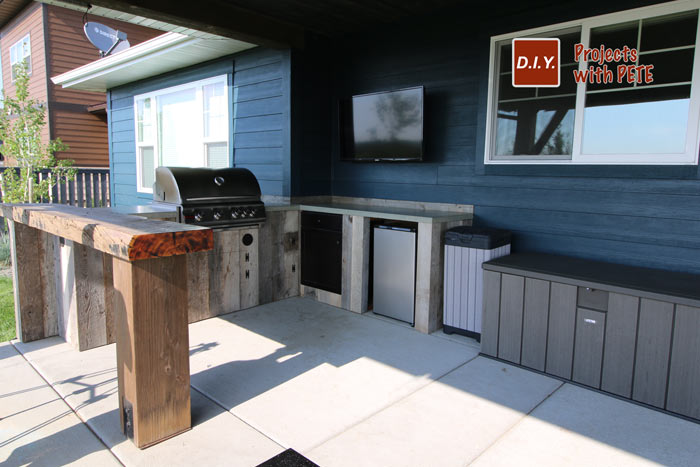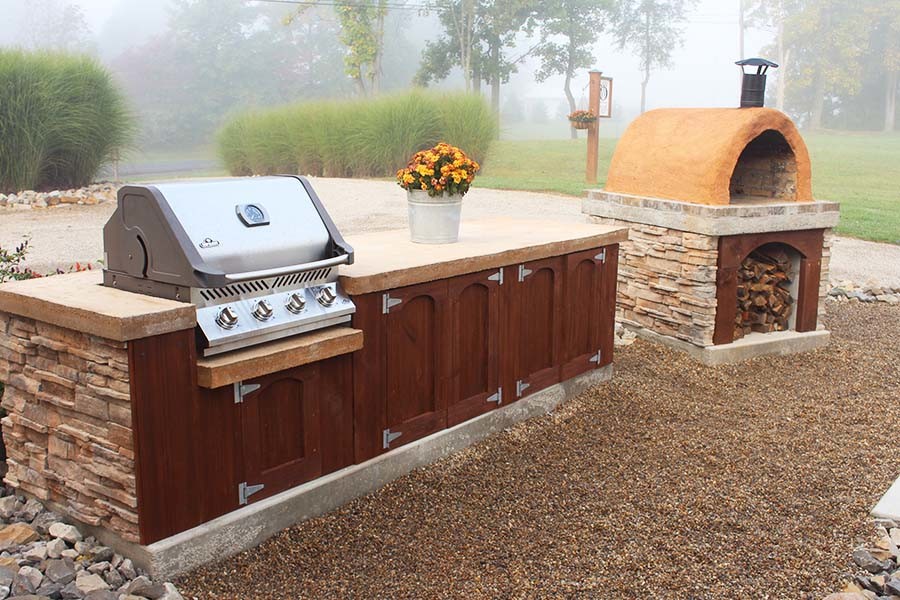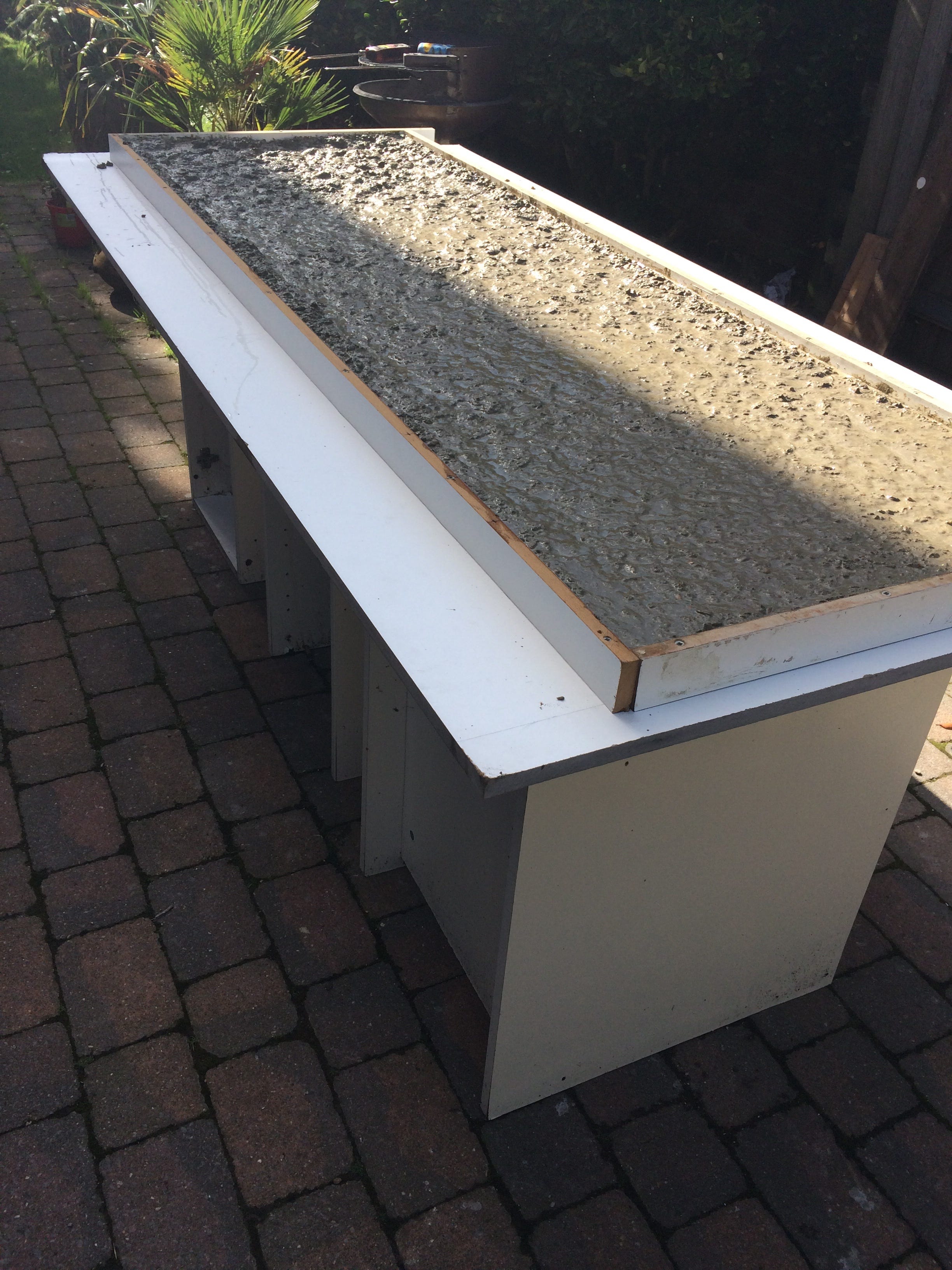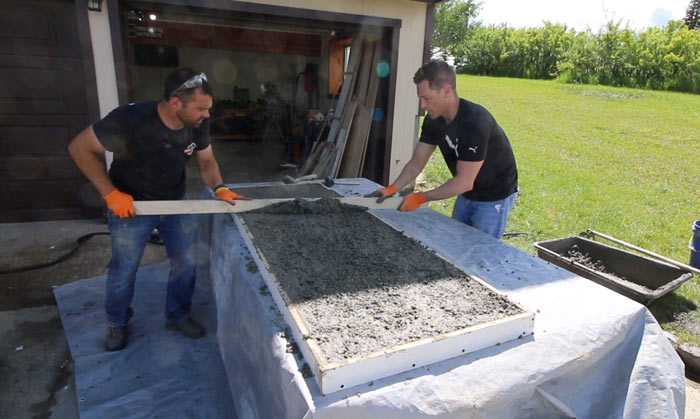Outdoor concrete countertops offer a durable, customizable, and modern solution for outdoor kitchen spaces. When it comes to creating an outdoor kitchen or entertainment area, concrete is a go-to material due to its strength and versatility. The idea of making your outdoor concrete countertop may seem daunting, but with the right approach, it’s a manageable DIY project that can bring both functional and aesthetic value to your space. One of the key advantages of concrete is that it can be poured and shaped into any size or form, giving you full control over your countertop’s design. This flexibility allows you to create a unique outdoor feature that perfectly fits your needs and style.
Concrete countertops are incredibly durable, making them perfect for the outdoors, where they must withstand various weather conditions. Concrete holds up well against heat, rain, and even snow, provided it’s properly sealed. For those of us who enjoy outdoor cooking or entertaining, this durability makes concrete an ideal choice, as it can handle the heat from grills and hot pans without damage. Additionally, concrete’s inherent strength means it won’t crack or warp easily, even when exposed to extreme temperatures, so you can expect your countertop to last for many years with minimal upkeep.
One of the more exciting aspects of making your outdoor concrete countertop is the opportunity to personalize it. You can choose the color, texture, and finish that suits your taste and outdoor décor. Adding pigments to the concrete mix allows you to achieve anything from sleek, polished surfaces to more rustic, earthy tones. You can even embed decorative elements like tiles, stones, or glass into the countertop for a one-of-a-kind look. This level of customization makes DIY concrete countertops stand out from pre-fabricated options, allowing you to truly make the space your own.
The process of creating a DIY outdoor concrete countertop starts with building a sturdy form. This is essential because the form will dictate the shape and thickness of your countertop. Forms are typically made from plywood or melamine, which creates a smooth finish on the underside of the countertop. Building the form may require some basic carpentry skills, but it’s a crucial step for ensuring the concrete is poured correctly. The good news is, that once the form is built, the rest of the process is fairly straightforward.

When mixing the concrete, you want to make sure you get the right consistency. Using a high-strength concrete mix is recommended for countertops since it provides the necessary durability. The mix should have a thick, pancake-batter consistency, which makes it easier to pour and shape. You can either mix the concrete by hand using a wheelbarrow and shovel or for larger projects, a rented cement mixer may be more efficient. During the pouring process, it’s important to vibrate the form to release any trapped air bubbles, as these can cause weak spots in the concrete if left unchecked.
After pouring the concrete, the curing process is critical. Concrete takes time to set and develop its full strength, so patience is key. It generally takes at least 48 hours for the concrete to harden enough to remove the form, but full curing can take up to a month. During this time, it’s essential to keep the surface moist and covered, which helps prevent cracking. Many DIYers use a plastic sheet to cover the countertop, ensuring that moisture levels are maintained during the curing process.
Once the concrete has cured, the next step is finishing the surface. This can involve sanding or polishing the countertop to achieve your desired smoothness and appearance. If you prefer a polished look, using finer grit sandpaper or a concrete polisher will help achieve a smooth, glossy finish. For a more textured look, a rougher sanding process may suffice. Sealing the countertop is another important step in ensuring its longevity. The sealer helps protect the concrete from moisture, stains, and outdoor elements, while also enhancing the color and texture of the surface.

Installing the concrete countertop requires careful placement, especially since concrete is heavy. Depending on the size of your countertop, you may need assistance to lift and set it into place. Once positioned, it’s typically secured with construction adhesive or screws, depending on the support structure beneath. One of the benefits of concrete is that it can easily be modified or adjusted during the installation process. If small imperfections arise, they can be fixed with additional concrete or sanded out.
Outdoor concrete countertops also offer the benefit of low maintenance. After sealing, they require little more than regular cleaning with mild soap and water. The occasional resealing, every few years, helps to maintain the countertop’s protective layer and keep it looking fresh. Unlike materials like wood or stone, concrete doesn’t need intensive care, making it an attractive option for those who want a hassle-free outdoor space. Stains and spills can be wiped away without the need for specialized cleaners, contributing to the countertop’s long-lasting appeal.
Beyond their practicality, concrete countertops offer a contemporary, modern aesthetic that works well with various outdoor settings. Whether your outdoor area is minimalist and sleek or rustic and casual, a concrete countertop fits right in. The raw, industrial vibe of concrete is a popular design choice for outdoor kitchens, blending seamlessly with stainless steel appliances, wood accents, or brick surrounds. The natural look of concrete is also versatile enough to complement surrounding landscaping, patios, and outdoor furniture.

Concrete countertops are also cost-effective compared to other outdoor materials like granite or marble. While the materials required for a DIY project – such as concrete, forms, and sealers – do have costs, the overall price is significantly lower than purchasing and installing stone countertops. For DIY enthusiasts, this affordability allows you to create a high-end outdoor kitchen without breaking the bank. Plus, since you’re handling the labor yourself, you save on installation fees, making it a budget-friendly project with a luxury feel.
The long-term benefits of an outdoor concrete countertop make it a smart investment. Not only do you gain a durable and attractive surface, but the value it adds to your outdoor space is significant. For those who enjoy entertaining outdoors, a well-designed concrete countertop enhances the usability and aesthetics of the area, transforming it into a more functional and enjoyable space for gatherings. Whether you’re prepping food for a cookout or simply serving drinks and appetizers, the countertop serves as a versatile surface for all your outdoor needs.
The environmental sustainability of concrete is another advantage worth noting. Concrete is made from abundant natural materials like limestone and clay, which makes it an eco-friendly option for outdoor countertops. Additionally, because concrete is long-lasting, it reduces the need for replacements and minimizes waste over time. If sustainability is a priority in your outdoor kitchen project, concrete aligns with eco-friendly principles, especially when you choose locally sourced materials or use recycled aggregates in your mix.

One aspect of DIY concrete countertops that I love is the sense of accomplishment that comes with completing the project. Not only do you get to enjoy the finished product, but knowing that you built it yourself adds a personal touch to your outdoor space. Every time you use the countertop, you’ll be reminded of the hard work and creativity that went into it. For DIY enthusiasts, the process of planning, building, and finishing the countertop is just as rewarding as the result itself.
Finally, outdoor concrete countertops provide the perfect balance of form and function. They offer a sturdy, weather-resistant surface while also allowing for endless design possibilities. Whether you want a bold statement piece or a subtle, natural look, concrete gives you the flexibility to create a countertop that suits your style. With the right planning and effort, a DIY outdoor concrete countertop can become the centerpiece of your outdoor kitchen, blending practicality with beauty in a way that enhances your entire outdoor living area.
Common Mistakes to Avoid
A common mistake in DIY outdoor concrete countertops is not building a strong enough form. If the form is flimsy or poorly constructed, the concrete may crack or sag. Additionally, improper sealing is another frequent mistake. Without the right sealant, concrete can absorb moisture, leading to cracks and discoloration. Rushing the curing process is another error; it’s important to give the concrete time to properly set to avoid future issues like cracks. Finally, not vibrating the concrete to remove air bubbles can weaken the countertop and result in a less durable surface.

How long does it take to build an outdoor concrete countertop?
The time it takes to build a concrete countertop varies depending on the size and complexity of the project. Typically, building the form, pouring the concrete, and allowing it to cure can take anywhere from a few days to a week. Full curing for maximum strength may take up to 28 days. Patience is key to ensuring the countertop is strong and durable.
What materials do I need to make a DIY concrete countertop?
The materials needed include high-strength concrete mix, plywood or melamine for the form, rebar or wire mesh for reinforcement, and a concrete sealer. Tools like a concrete mixer, trowel, and sander may also be required. These materials and tools are readily available at most home improvement stores, making it a relatively accessible DIY project.
Do I need to seal my concrete countertop?
Yes, sealing your concrete countertop is crucial. Sealant protects the surface from stains, moisture, and weather-related damage. Outdoor countertops are especially exposed to the elements, so a high-quality outdoor sealer will help maintain its appearance and durability. Resealing every couple of years is recommended to ensure long-term protection.

Can I add color to my concrete countertop?
Absolutely! Pigments can be added to the concrete mix to achieve a variety of colors. You can choose from subtle earth tones to bold, vibrant shades. You can even experiment with different finishes or techniques, like acid staining or adding colored aggregates, to create a custom look that suits your outdoor kitchen design.
How do I care for an outdoor concrete countertop?
Caring for a concrete countertop is relatively simple. Regular cleaning with mild soap and water is all it takes to maintain the surface. Avoid using harsh chemicals that can wear down the sealer. Resealing every couple of years is essential to keep the countertop protected from outdoor elements like rain and sun.
Can I fix cracks in my concrete countertop?
Small cracks can sometimes develop over time, but they’re often repairable. You can use a concrete patching compound to fill the cracks and sand it down for a smooth finish. For larger cracks, it may require a more involved repair, but in most cases, cracks don’t affect the structural integrity of the countertop if addressed early.

How to Make Concrete Counters for an Outdoor Kitchen – DIY Pete

Exterior Concrete Countertops

Related articles: